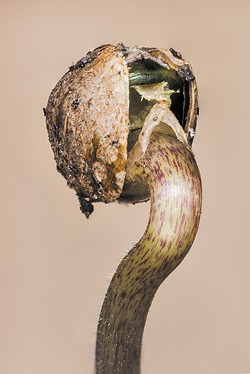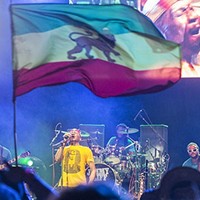[
{
"name": "Top Stories Video Pair",
"insertPoint": "7",
"component": "17087298",
"parentWrapperClass": "fdn-ads-inline-content-block",
"requiredCountToDisplay": "1"
}
]
This past Sunday festivalgoers at Reggae on the River reveled in good vibes, positive sounds and gorgeous summer weather. Any storm clouds that might be gathering in Babylon were far from the collective consciousness of this happy crowd. Coot Wyman, the affable frontman of the Chico reggae fusion band Mystic Roots, exhorted us to smile and assured us we all looked beautiful. He moved to pre-empt any audience concerns regarding his fresh haircut with good humor: "I know you expect me to have some dreads, but I need more room for weed in me head." The crowd loved it.
Up next in the lineup, London-based singer Marla Brown reiterated a positive message in her upbeat, pop-infused songs. Later in the day, roots reggae vocalist and songwriter Dezarie, from the U.S. Virgin Islands, regaled an appreciative crowd with songs like "Mamma Knows Best," speaking to women reggae artists' ongoing struggle to achieve recognition and gender parity — no easy achievement in a genre still heavily influenced by the patriarchal beliefs prevalent in orthodox Rastafarianism. It was hard not to interpret Dezarie's song selection as a callback to "Jah Knows Best," one of the modern-day classics of the roots reggae genre, recorded by Sizzla in 2004. "Message music is the future," she told the audience. "Recognize your true worth!"
Three flags were waving in front of the stage: the flag of the U.S. Virgin Islands, a tricolor flag with a Rastafari lion rampant, and a flag reproducing the design of the United States flag in black and white, with a green cannabis leaf positioned in the upper quarter where the stars normally appear.
Afternoon heat kept some festivalgoers in the shade, but those sun-worshippers who did get on their feet enjoyed a lot of space for personal expression. Hula-hoopers and hacky-sackers did their thing. Volunteers used fire hoses to cool the dancers down. Sweaty revelers went slip-sliding in the spray. One man danced on stilts; one played a didgeridoo. "I got that ecstasy," a third said quietly to passersby.
"Is that a didgeridoo?" someone inquired.
"No, it's a dildo," the drone purveyor shot back.
Katherine Ramirez of Mystic Roots was calling from the stage, "How 'bout the ladies? Can I get a ganja song for the ladies?" the crowd raised a cheer in response: yes she could.
Over in the art zone, Ferndale-based surf artist Shawn Griggs made a strong showing with his signature oil paintings of skeleton surfers riding gnarly waves. The skeletons are among the elements of imagery Griggs draws from the Mexican holiday Dia de las Muertes, Day of the Dead, which, he says, "has found a firm hold within my imagination." Griggs describes himself as "an avid Humboldt County surfer with a hunger for travel," and the beaches and rocky headlands that appear in his paintings reflect the scope of that experience. The large landscape he was working on over the weekend may represent a new direction; it's an intricately painted aerial view of the festival by night that shows packed dancers gyrating in the concert bowl and the hills rising up behind it, a full moon rising above.
In the festival's Art Cave, close-up photographic prints of cannabis stood out from the flights of red, green, black and gold paintings that surrounded them. They are credited to Evan Moore of CannaGraphics, a fledgling Humboldt-based startup dedicated to "macro cannabis trichrome photography." You've seen seeds and buds before, but maybe not like this. In these photographs, plant parts are isolated against clean monochrome backgrounds and viewed in extreme close-up. You are able to see individual pistils and stamens at this scale, as you would if you were inspecting a bud under a low-powered microscope. A macro view of the spiral nodule that forms when a seed has just begun to quicken re-enchants the germination process, making the plant's birth seem like an event.
Despite the photographs' striking qualities, it's fair to say the longstanding popularity of these types of close-up views in the cannabis press has tempered their novelty effect. Ever since indelibly colorful entrepreneur Tom Fourcade founded industry pioneer High Times in 1974, one of the most important parts of the magazine has been its centerfold spreads, where enticingly detailed close-up photographs of frosty buds appear each month in witty emulation of the Playboy template introduced by Hugh Hefner 20 years earlier.
In short, these grower's eye views will be familiar to the cannabis cognoscenti who make up a higher-than-average percentage of the ROTR viewing public. Like most other examples of contemporary cannabis imagery, Hamilton's pictures straddle the art/commerce divide, illustrating the degree to which cannabis imagery remains entwined with the industry's commercial side. What any of this has to do with reggae music is, well, history.
The degree to which the reggae establishment and the burgeoning cannabis industry are mutually supporting and cross-branded means that it is becoming increasingly difficult to distinguish commercial from non-commercial uses — ironic for a musical genre that promotes anti-corporate values. Maintaining a healthy distance from Babylon is likely to involve increasingly nimble acts of self-justification. Or maybe the fabled metropolis was never really as remote as some believed.
For more information about the work of the artists mentioned in the article, see www.redeyelaboratories.com and www.canna-graphics.com.
more from the author
-
Nancy Tobin's CRy-Baby Installation at CR
- Feb 22, 2024
- More »

































